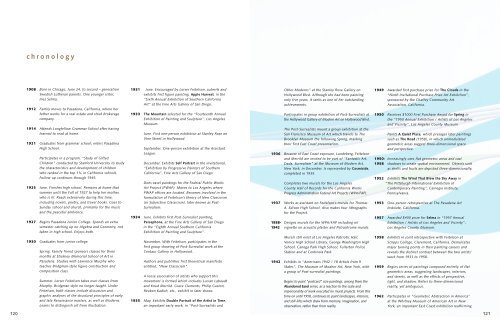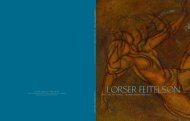helen lundeberg - Louis Stern Fine Arts
helen lundeberg - Louis Stern Fine Arts
helen lundeberg - Louis Stern Fine Arts
You also want an ePaper? Increase the reach of your titles
YUMPU automatically turns print PDFs into web optimized ePapers that Google loves.
chronology<br />
1908 Born in Chicago, June 24, to second – generation<br />
Swedish Lutheran parents. One younger sister,<br />
Inez Selma.<br />
1912 Family moves to Pasadena, California, where her<br />
father works for a real estate and stock brokerage<br />
company.<br />
1914 Attends Longfellow Grammar School after having<br />
learned to read at home.<br />
1921 Graduates from grammar school; enters Pasadena<br />
High School.<br />
Participates in a program, “Study of Gifted<br />
Children” conducted by Stanford University to study<br />
the characteristics and development of children<br />
who ranked in the top 1% in California schools.<br />
Follow-up continues through 1945.<br />
1925 June. Finishes high school. Remains at home that<br />
summer until the Fall of 1927 to help her mother,<br />
who is ill. Reads extensively during this time,<br />
including novels, poetry, and travel books. Goes to<br />
Sunday school and church, primarily for the music<br />
and the peaceful ambience.<br />
1927 Begins Pasadena Junior College. Spends an extra<br />
semester catching up on Algebra and Geometry, not<br />
taken in high school. Enjoys both.<br />
1930 Graduates from junior college.<br />
Spring. Family friend sponsors classes for three<br />
months at Stickney Memorial School of Art in<br />
Pasadena. Studies with Lawrence Murphy who<br />
teaches Bridgman-style figure construction and<br />
composition class.<br />
Summer. Lorser Feitelson takes over classes from<br />
Murphy. Bridgman style no longer taught. Under<br />
Feitelson, both classes include discussion and<br />
graphic analyses of the structural principles of early<br />
and late Renaissance masters, as well as Moderns.<br />
Learns to distinguish art from illustration.<br />
1931 June. Encouraged by Lorser Feitelson, submits and<br />
exhibits first figure painting, Apple Harvest, in the<br />
“Sixth Annual Exhibition of Southern California<br />
Art” at the <strong>Fine</strong> <strong>Arts</strong> Gallery of San Diego.<br />
1933 The Mountain selected for the “Fourteenth Annual<br />
Exhibition of Painting and Sculpture”, Los Angeles<br />
Museum.<br />
June. First one-person exhibition at Stanley Rose on<br />
Vine Street in Hollywood.<br />
September. One-person exhibition at the Assistant<br />
League.<br />
December. Exhibits Self Portrait in the invitational,<br />
“Exhibition by Progressive Painters of Southern<br />
California”, <strong>Fine</strong> <strong>Arts</strong> Gallery of San Diego.<br />
Does easel paintings for the Federal Public Works<br />
Art Project (PWAP). Moves to Los Angeles where<br />
PWAP offices are located. Becomes involved in the<br />
formulation of Feitelson’s theory of New Classicism<br />
(or Subjective Classicism), later known as Post-<br />
Surrealism.<br />
1934 June. Exhibits first Post-Surrealist painting,<br />
Persephone, at the <strong>Fine</strong> <strong>Arts</strong> Gallery of San Diego<br />
in the “Eighth Annual Southern California<br />
Exhibition of Painting and Sculpture”.<br />
November. With Feitelson, participates in the<br />
first group showing of Post-Surrealist work at the<br />
Centaur Gallery in Hollywood.<br />
Authors and publishes first theoretical manifesto<br />
entitled, “New Classicism”.<br />
A loose association of artists who support this<br />
movement is formed which includes Lucian Labaudt<br />
and Knud Merrild. Grace Clements, Philip Guston,<br />
Reuben Kadish, etc., exhibit in later shows.<br />
1935 May. Exhibits Double Portrait of the Artist in Time,<br />
an important early work, in “Post-Surrealists and<br />
Other Moderns” at the Stanley Rose Gallery on<br />
Hollywood Blvd. Although she had been painting<br />
only five years, it ranks as one of her outstanding<br />
achievements.<br />
Participates in group exhibition of Post-Surrealists at<br />
the Hollywood Gallery of Modern Art on Hollywood Blvd.<br />
The Post-Surrealists mount a group exhibition at the<br />
San Francisco Museum of Art which travels to The<br />
Brooklyn Museum the following Spring, marking<br />
their first East Coast presentation.<br />
1936 Because of East Coast exposure, Lundeberg, Feitelson<br />
and Merrild are invited to be part of “Fantastic Art,<br />
Dada, Surrealism” at the Museum of Modern Art,<br />
New York, in December. Is represented by Cosmicide,<br />
completed in 1935.<br />
Completes two murals for the Los Angeles<br />
County Hall of Records for the California Works<br />
Progress Administration Federal Art Projects (WPA/FAP).<br />
1937 Works as assistant on Feitelson’s murals for Thomas<br />
A. Edison High School. Also makes four lithographs<br />
for the Project.<br />
1938- Designs murals for the WPA/FAP including oil<br />
1942 vignette on acoustic plaster and Petrachrome murals.<br />
Murals still exist at Los Angeles Patriotic Hall,<br />
Venice High School Library, George Washington High<br />
School, Canoga Park High School, Fullerton Police<br />
Station and at Centinela Park.<br />
1942 Exhibits in “Americans 1942 / 18 Artists from 9<br />
States”, The Museum of Modern Art, New York, with<br />
a group of Post-surrealist paintings.<br />
Begins to paint “postcard” size paintings, among them the<br />
Abandoned Easel series, as a reaction to the scale and<br />
impersonality of work executed on mural projects. From this<br />
time on until 1958, continues to paint landscapes, interiors,<br />
and still-lifes which draw from memory, imagination, and<br />
observation, rather than from reality.<br />
1949 Awarded first purchase prize for The Clouds in the<br />
“Ninth Invitational Purchase Prize Art Exhibition”,<br />
sponsored by the Chaffey Community Art<br />
Association, California.<br />
1950 Receives $1000 First Purchase Award for Spring in<br />
the “1950 Annual Exhibition / Artists of Los Angeles<br />
and Vicinity”, Los Angeles County Museum.<br />
Paints A Quiet Place, which presages later paintings<br />
such as The Road (1958), in which unmodulated<br />
geometric areas suggest three-dimensional space<br />
and perspective.<br />
1950- Increasingly uses flat geometric areas and cast<br />
1958 shadows to create spatial environment. Objects such<br />
as shells and fruits are depicted three-dimensionally.<br />
1952 Exhibits The Wind That Blew the Sky Away in<br />
“The Pittsburgh International Exhibition of<br />
Contemporary Painting”, Carnegie Institute,<br />
Pennsylvania.<br />
1953 One-person retrospective at The Pasadena Art<br />
Institute, California.<br />
1957 Awarded $400 prize for Selma in “1957 Annual<br />
Exhibition / Artists of Los Angeles and Vicinity”,<br />
Los Angeles County Museum.<br />
1958 Exhibits in joint retrospective with Feitelson at<br />
Scripps College, Claremont, California. Demarcates<br />
major turning points in their painting careers and<br />
reveals the distinct contrast between the two artists’<br />
work from 1933 to 1958.<br />
1959 Begins series of paintings composed entirely of flat<br />
geometric areas, suggesting landscapes, interiors,<br />
and streets, as well as the effects of perspective,<br />
light, and shadow. Refers to three-dimensional<br />
reality, yet ambiguous.<br />
1962 Participates in “Geometric Abstraction in America”<br />
at the Whitney Museum of American Art in New<br />
York, an important East Coast exhibition reaffirming<br />
120 121





